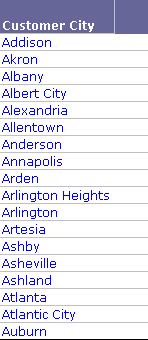MicroStrategy ONE
Filtering data by comparing attributes through attribute forms
For some purposes, you may need to filter on an attribute based on criteria related to another attribute or related to a custom expression.
For example, your new utility company has call centers located throughout the country, and your recent surveys indicate that customers who live in the same city as a call center are particularly satisfied with service due to extremely rapid repairs during power outages. To begin your new advertising campaign, you want to generate a list of Call Centers that coincide with Customer Cities. In this case, you qualify on the Customer City and Call Center attributes using an attribute-to-attribute qualification filter. (For general instructions to create an attribute-to-attribute qualification, see Creating an attribute qualification. For specific instructions to create the filters for these examples, see the Advanced Filters chapter in the Advanced Reporting Help.)
When you add this filter to a report that displays customer cities, only a small subset of the total number of Call Center attribute elements is displayed. Each of the elements (cities) present on the report is also a Customer City.

In another scenario, your next marketing campaign is targeted towards customers with income below $100,000 a year. This requires an attribute-to-attribute qualification filter to qualify on the Income Bracket attribute, but in this case, the second item qualified on is a custom expression instead of an attribute. For the complete example, including instructions to re-create it, see the Advanced Filters chapter in the Advanced Reporting Help.
Attribute-to-attribute qualification filters always require the use of custom expressions. For a more comprehensive discussion of custom expressions, Apply functions, and examples, refer to Creating a custom expression qualification.
